| |
“You need this ultra-violent, ultra-notorious rape-revenge nightmare like a fire-extinguisher-shaped hole in the head.” |
| |
Peter Bradshaw – The Guardian* |
| |
“Irréversible is a film that attempts to knock you out, literally, but in doing so also achieves a level of artistic honesty that belies its base motives. For that, we should all be thankful.” |
| |
Mark Kermode, Sight & Sound, February 2003 |
It's hard to put into words the genuine shock to the system that Gasper Noé's 2002 Irréversible had on its release and frankly is still able to deliver today. Even 19 years after it first hit cinema screens there are doubtless many cineastes who have never seen it and likely even a few who have never heard of it. There are also, I would imagine, a sizeable number who have read enough about it to convince themselves that they never want to watch it, and just as many who have seen it once and have no desire to sit through it a second time. I can understand that. I have friends for whom extreme cinema is part of their staple diet but who shake their heads and grimace when you bring up Irréversible. Indeed, when Indicator was preparing to send out its monthly review discs, for the first time since the label came into being we were all asked to confirm whether we wanted to cover this one, the expectation being that some would rather not. I, as you have doubtless already gathered, am not one of those people.
For those of you who are new to the film, Irréversible is a reverse-narrative rape-revenge story that offers a new take on a subgenre that regularly attracts charges of exploitation, hardly surprising given that two of its most famous torchbearers are Wes Craven's 1972 The Last House on the Left and Meir Zarchi's 1978 I Spit on Your Grave. But if Zarchi's film often gets cited as the genre's nadir, Craven's is regarded by many as a more complex work than its surface horror suggests. It’s also worth remembering that it was a partial remake of Ingmar Bergman's 1960 The Virgin Spring, which makes that film the unwitting godfather of a genre that Bergman himself would doubtless have shuddered at the idea of being even tentatively associated with. Balancing exploitation with more serious concerns has been a difficulty for any filmmaker wandering into this morally dubious area, from Sam Peckinpah's 1971 Straw Dogs to Abel Ferrera's 1981 Ms. 45 and Tony Garnett's 1983 Handgun. All have their enthusiastic supporters, but also have their share of very vocal detractors and it's easy to see why – the victims are usually female, the filmmakers male, and any trivialisation of a crime as thoroughly wretched as rape usually deserves every brickbat thrown in its direction. That few of us have the same reaction to on-screen murder perhaps (and I do mean perhaps, because I’m fully aware that there are other factors at play here) says more about its cinematic frequency than it does about how seriously we regard the crime itself.
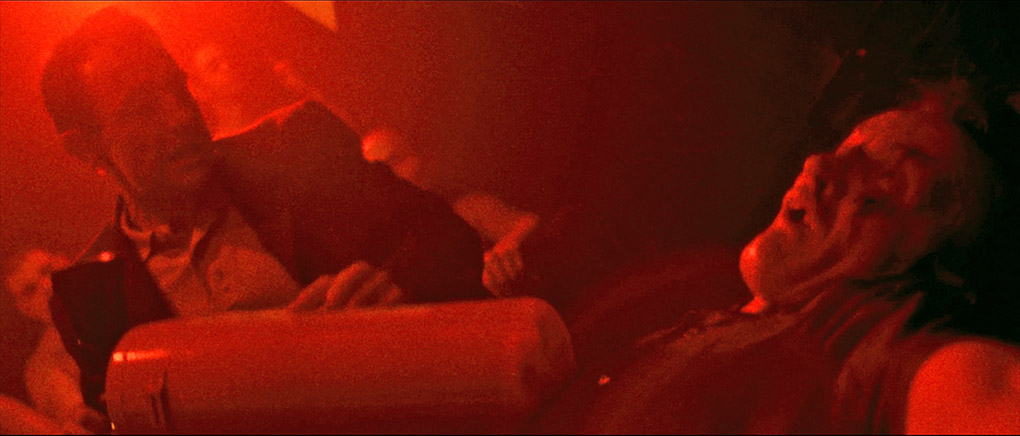
If opinion was divided on the above-named films, then it was completely polarised by Gasper Noé's Irréversible. Noé himself is no stranger to controversy – the central character of his 1998 debut feature Seul contre tous was a sexist and racist homophobe whose spleen-venting monologues and brutal assault on his pregnant partner and incestual desires make him one of the most unlovable anti-heroes in modern cinema. Intriguingly, this character makes a brief appearance at the very start of Irréversible, sitting naked in a room and reflecting to a friend on time he spent in jail for the crime he was in the process of committing as the earlier film came to deeply discomforting close. Yet despite the controversy that surrounded Seul contre tous on its release, Irréversible sparked even deeper critical divisions, with accusations of attention-seeking exploitation and a childish determination to shock at all costs going head-to-head with praise for the film's daring, intelligence and thunderous power. This battle of opinions was given lucid voice in the February 2003 issue of Sight & Sound, where critics Nick James and Mark Kermode justified in some detail their opposing standpoints on the film.
So, what exactly is the problem here? The debate, for those who do not know, revolves largely around two genuinely horrifying scenes. We first catch the aftermath of the first (chronologically the second) at the start of the film, as the camera drifts down towards the entrance of a gay nightclub called Rectum (yeah, I know) and an injured young man named Marcus (Vincent Cassel) is wheeled out on a stretcher and his shell-shocked friend Pierre (Albert Dupontel) is led out in handcuffs by the police. The film then hops back 20 minutes or so to when the two men have just arrived at the club and are urgently questioning patrons about the location of a man known as Le Tenia (Jo Prestia). When Marcus angrily confronts the individual he believes is the target of their search, a fight breaks out and he is pushed to the floor and his arm is broken. He is on the verge of being raped by the man he was accusing when the initially more reluctant Pierre grabs a fire extinguisher and beats the would-be rapist’s head to a bloody pulp, an assault whose extended viciousness goes way beyond its initial purpose of fury-fuelled retaliation for violence inflicted on his friend. The first blow sees to that – the subsequent twenty-two are about something else entirely.
If you didn’t realise it before sitting down the film for the first time (and I’m guessing that few will approach it without some foreknowledge of this), then it won't be long before you realise that this is not a flashback but the second sequence in a reverse-structured narrative of the sort made famous by Christopher Nolan's Memento. Here the story unfolds in the manner (though definitely not the style) of a news report, as we stumble onto an incident whose backstory is then gradually revealed through a process of retrospective cinematic investigation. Another time-hop back finds Marcus riding on fury. On his way to the club he assaults a taxi driver and steals his cab, loses his rag in a café and smashes the windows of the taxi to stop Pierre from driving off and leaving him. Pierre is increasingly revealed as a somewhat unwilling accomplice, repeatedly trying to dissuade his volatile companion from doing anything rash. "What's your anger about?" he asks him. "Fucking B-movie revenge crap!"
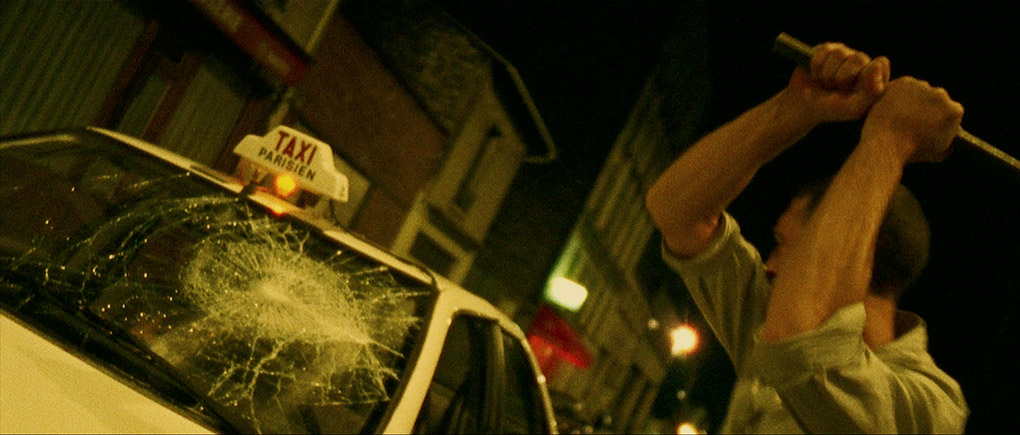
We're a fair way back into the story when we get the first real hints about the source of Marcus's rage and Pierre’s subsequent explosion of lethal anger. Someone has been raped, we are told, and another hop backwards finds both men in a state of shock, reacting to something that we have yet to witness and being propositioned by a local gangster (Mourad Khima) who calmly assures Marcus that "until proof to the contrary, I can be your best friend." This new friend knows the name of the man who committed the crime that they have been so shaken by, and for a fee he promises to help make him suffer. The film then moves back in time again, and Marcus and Pierre at this point are still happy, but not for long. They walk out into the street from a party and are almost immediately confronted with the end result of the incident that will set them on the path to vengeance. By now we know the nature of the crime and have seen its terrible consequences. Are we apprehensive? You genuinely don't know the half of it.
As the next jump back begins, the camera follows an as-yet unidentified woman whom we later learn is Marcus’s partner (and Pierre’s ex-partner) Alex (Monica Bellucci), out of a building, into the street and down into a red-walled subway, and there will be few who do not fear what is soon to follow. I can almost guarantee that it's far worse than anything you will imagine or expect. This scene has been the key focus of discussion and audience horror and outrage since the film first screened at Cannes back in May 2002, and I would imagine at least partly responsible for its reputation as one of the most walked-out of movies in modern cinema – a staggering two hundred people left during the Cannes screening alone. It is, without question, an almost unbearable scene to watch, a repulsively brutal rape that is shown in its entirety and in real time as a single, static shot that is held for agonising length and followed by a beating violent enough to make even the most hardened viewer recoil.
The argument against the film can certainly be said to have ammunition here. On the surface, at least, this scene does seem to be designed solely to out-shock everything that even extreme cinema had given us before, guaranteeing the film the sort of press coverage that will garner it an audience based on the resulting controversy alone. And, of course, there's the gimmick of the backward-running narrative, and I haven't even mentioned the wild, disorientating camerawork and the anxiety-inducing soundtrack. Exploitation cinema at its most irredeemable, then? It's certainly an easy case to make based on the evidence as listed, but to do so entails shutting your eyes, ears and intellect to Noé's clear sense of purpose and to the film's very considerable achievement both as drama and as cinema. For a start, the reverse-narrative structure is purposefully employed, inverting the usual dramatic setup of introducing characters first and the narrative disruption later, and by doing so it undermines the structure of the rape-revenge genre itself. Here revenge provides no visceral thrills or sense of moral satisfaction because we have no emotional investment in the characters or their backstory at this stage. Later, we might look back and maybe feel that Le Tenia got what he deserved, but you don't get to enjoy the vengeance in the usual manner, and a second viewing reveals that's it's not Le Tenia who takes the beating anyway but an unfortunate friend, one whose murder Le Tenia watches and appears to enjoy.
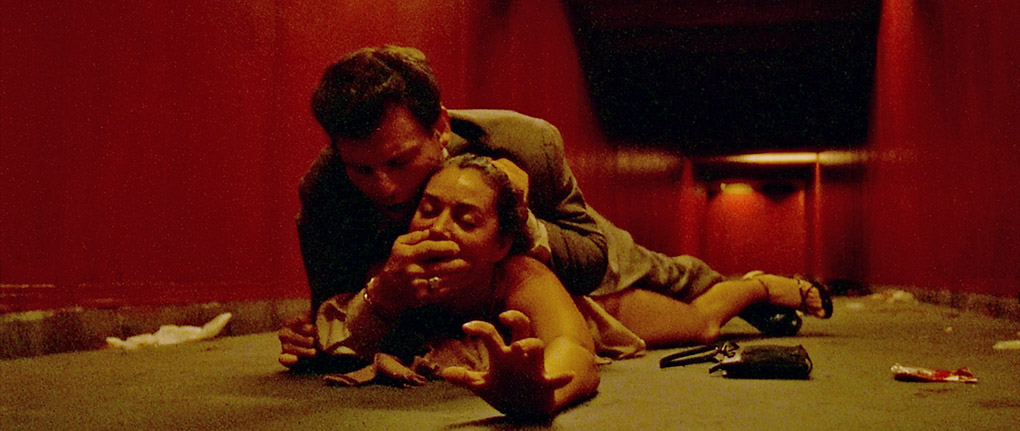
If the rape itself is sickening to watch then it damned well should be, and though you'll really want to turn your head away, you absolutely shouldn't. Noé himself has stated that that men seem to find the scene even more unbearable to watch than women, as they are forced into the situation of identifying completely with the victim and understanding just something of the sheer awful horror of what it is to be so assaulted (the gender barrier to identification is further destroyed by the nature of the attack itself, which could just as easily have been inflicted on a man). So unwavering is the camera's stare, so gut-wrenchingly real does Alex's suffering feel, that we as an audience become inevitably complicit in the crime, unable to intervene or respond to the hand that reaches out desperately for our help. I swear you'll never hear the word 'rape' again without recalling this scene, and you'll never hear it used lightly by anyone without wanting to subject them to A Clockwork Orange’s Ludovico Treatment with this sequence used as corrective medicine. When I first watched this scene on the film’s initial release, I was left shaken. This time around I was wiping away tears.
The camera at times feels chained to the emotional state of the characters it observes, the frantically mobile, almost unframed insanity of Marcus and Pierre's arrival at Rectum settling down over the course of the film to an eventual Stedicam calm as we and they are transported back to less troubled times. Elsewhere it echoes the rhythm of an anguished heartbeat, or drifts around rooms and between locations like a half-formed memory, an experience captured only in essence rather than in fine detail.
The editing is largely invisible, the impression being of a film told in a single wandering shot, short chapters digitally linked to allow the camera to fly between moving vehicles and in and out of closed windows like a curious insect. The aplomb with which the camera operators (often Noé himself) and the actors pull off the largely unscripted ten-to-fifteen-minute sequences is quietly mesmerising. The most complex of shots is so casually executed that it's only afterwards that you realise we have followed the three leads down into a Metro station, onto a train and stayed with them for the three stops to their destination in one unbroken ten minute take, with them confidently and entertainingly improvising dialogue the whole way.
Sound plays an equally important role in grinding the opening scenes into the viewer’s consciousness, a single electronic chord that builds in volume and intensity that is underscored by a low frequency rumble pitched at 27hz, the sort of half-audible tone that has been proven to induce anxiety and even nausea in those who hear it. Used in some countries by riot police to disperse crowds, this technique has been credited with as many walkouts as the rape scene – how effective this will be on Blu-ray will depend in part on the quality of the sound system through which it is played.
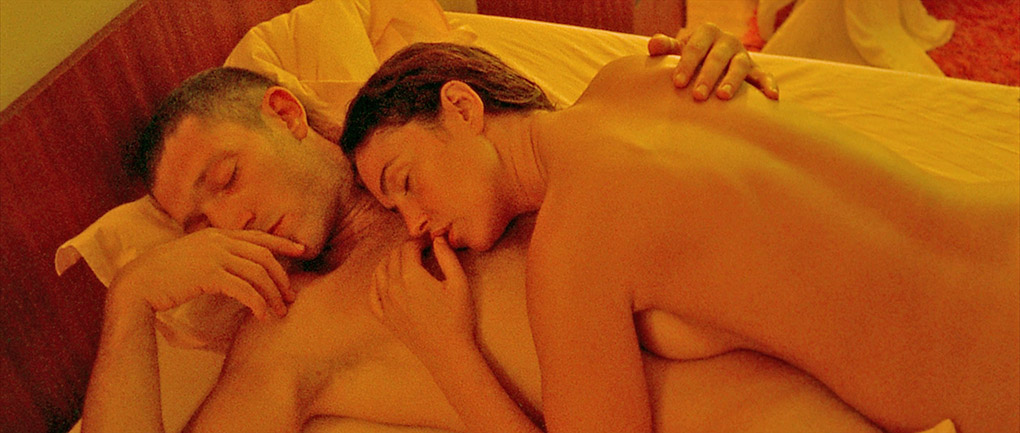
By inverting the narrative, Noé also robs the film of a traditional climactic scene, instead providing a compelling backward journey from darkness into light, ending with sense of loving serenity that is nonetheless tarnished by the foreknowledge of the fate that is soon to befall characters we by then know and care for. Twice we are told that "time destroys all things," a truism of the cycle of nature that is here robbed of the optimism of rebirth and evolutionary progression. Or is it? This narrative structure suggests that the future is already written (this is also a briefly mentioned component of the book Alex is reading, An Experiment in Time by J.W. Dunne) and that we are prisoners of fate, and your response to the ending will depend on whether you share this viewpoint. I do not. The very notion of a pre-determined future absolves everyone of responsibility for their actions and makes a mockery of free will and even the glorious wonders of chance, and chance plays as a big a role in Alex's fate as the actions of her twisted attacker. With that in mind and with infinite possibilities for any future, the ending of Irréversible can be seen to shine a ray of hope on its own searing vision of a dark and unpleasant world.
There are still issues that need addressing here, not least what could be read as homophobic overtones in the portrayal of the Rectum club a red-light-bathed hell whose patrons become sexually aroused at the prospect of witnessing a rape (Noé's cameo as a masturbating man here is reportedly due to his own concerns over this possible perception), but in the great debate over Irréversible's merits or otherwise, I am fully prepared to offer a loud shout in its support. Although as difficult and challenging a film as you'll find on Blu-ray anywhere at the moment, it's also a bold, brilliantly acted and executed work that genuinely assaults the senses and, for those with the stamina to see it through, really does reward the intellect.
For a film shot on Super-16, transferred to HD and manipulated in a variety of ways before being blown up to 35mm, Irréversible looks insanely good here. Framed in its original theatrical aspect ratio of 2.35:1, the level of detail often belies its origin format and the low light under which much of it was shot. The film grain, however, is clearly visible, particularly in the night-time exteriors, but this is never distracting and gives the image an almost tactile feel that HD has yet to reproduce. The contrast balance is well pitched to preserve the tone of the visually darker sequences but still ensures that relevant detail is clearly visible, and the film’s use of colour, which bathes whole scenes in a particular shade, is faithfully reproduced here without feeling overpowering. The picture is clean and free of dust or damage, and stays so for the end-of-film explosion of strobe light that the sensitive might want to close their eyes for.
I should note that the screen grabs included here are darker than the film appears on-screen, and that's down to the software I use to get them. I've cheated and lightened them a tad or you'd see nothing, but on a well-calibrated TV the images are clear and distinct even in darker scenes.
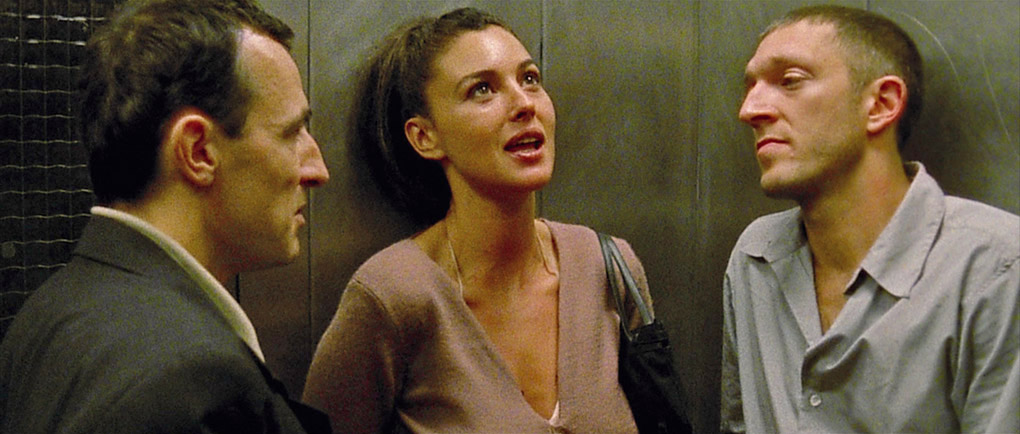
There are two soundtrack options in the shape of DTS-HD Master Audio 5.1 surround and DTS-HD Master Audio 2.0 stereo. This is a film in which sound plays a crucial role, and if you can the run the film in 5.1 surround through a system that has a decent subwoofer, you’ll be hearing it at close to its best. Sonically, the surround track is noticeably richer and more expansive than the stereo, but it really comes into its own in the deep 25hz rumble employed in the early scenes, which the stereo track just cannot reproduce anything like as effectively. Both tracks have excellent clarity and dynamic range, however, so dialogue is always clear and music full-bodied, although it’s definitely more so on the 5.1 track.
Optional English subtitles are activated by default but can be switched off on the main menu or on the fly using the player remote.
Before I get started on the special features, I just have to applaud the extra mile that Indicator went in order to give this disc its definitive edition feel. This attention to detail includes the way the colour scheme used on the menus reflect those used in the film, replicating Noe’s use of surnames only on the titles of the special features and – my favourite touch – modifying the Indicator logo to flip the N and the R in the manner of the film’s main title and adding a small but perfectly pitched strobe effect. I love stuff like this. Bravo.
DISC 1
Audio Commentary with Noé
Imported from the previous Collector’s Edition DVD release, this commentary by Noé is crammed from start to finish with information on the making of the film, and if you’re not a fluent French speaker (Je ne suis pas), you’ll need to keep your eyes glued to the screen to follow the subtitles, as Noé rarely seems to pause for breath. Rather than providing an overview, he comments on the action as it unfolds, imparting information on the thinking behind the shooting of individual scenes, the lighting, the camerawork, the special effects, the locations, the credits, the non-professional extras, the improvised dialogue, the lead actors, his influences, the use of the 27hz frequency to enhance audience anxiety, and lots more. The only downside of this tidal wave of information (and I’m absolutely not complaining) is that you’ll be hearing some of it several times more during the course of the special features, though often with specific details expanded on or from an alternative perspective. One of my favourite comments has Noé claim that, “It’s often the nicest people that make the scariest films.”
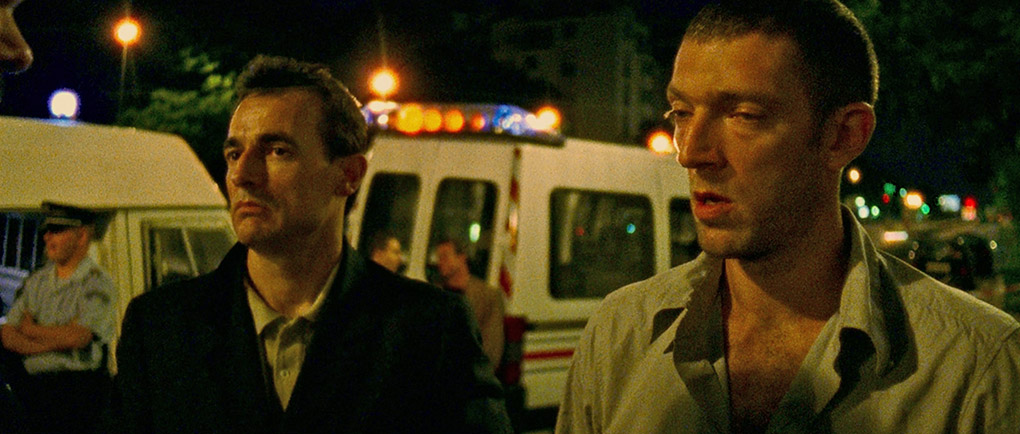
The Irréversible Odyssey (43:20)
A retrospective documentary about the making of the film, produced in 2019 for StudioCanal and built around interviews with director Gaspar Noé, lead actors Monica Bellucci and Vincent Cassel (who were married when the film was made and still appear to be pleasingly close), fellow actors Albert Dupontel and Joe Prestia, producers Vincent Maraval, Richard Grandpierre and Christophe Rossignon, cinematographer Benoît Debie, and director of the 2002 Cannes Film Festival, Thierry Fremaux, the man primarily responsible for getting the film screened in competition. Together they trace the development of the film from its birth as a low-budget work to be made whilst Noé was waiting to start Into the Void right through the process of its filming to its screening at Cannes – which is covered in considerable detail – and its release, controversy and critical reception. There is some inevitable crossover with other extras here, but this is still a comprehensive and informative feature that benefits greatly from being told from a variety of viewpoints. Although listed second on the special features, frankly I’d make this your first stop after watching the film. Excellent.
NFT50 Q&A with Bellucci, Cassel and Noé (49:07)
Conducted by Hannah McGill at the National Film Theatre in London on 11 October 2002, following a screening of Irréversible and as part of the BFI’s celebration of fifty years of the NFT, this carries the usual warning that it was recorded for archival purposes and is thus not sonically ideal, but the only problem I had was hearing some of the audience questions. There’s actually a brief pre-screening introduction by Noé, where Monica Bellucci says a few words (very few, as it happens), as she was not able to stay for the post-film Q&A. Noé does the lion’s share of the post-screening talking, aided by useful contributions from Cassell, with subjects covered including the initial evolution of the project, shooting the rape scene, the addition of a CGI penis in one shot, how the colours and camera movements change over the course of the story, the Cannes screening, Noé’s cameo as a masturbating man at the Rectum club, and more. Noé suggests that the use of the 27hz frequency could make a cat drinking milk seem scary and confirms that men seem to have been more offended by the rape scene than women, while Cassell reveals that this was the only film on which he has worked where he had stage fright every day due to the need to improvise dialogue. Another terrific inclusion.
The BFI Masterclass with Noé (90:06)
An on-stage interview with Noé, conducted by David Cox at London’s BFI Southbank on 16 October 2009 as part of that year’s London Film Festival, with Enter the Void having screened the previous day and again that very morning. It again carries a warning about having been recorded for archival purposes only, but I had no problems at all with this one, as when the interview is opened up for audience questions, a microphone is handed to the speaker and their words are thus always crystal clear. Here, guided by Cox, Noé talks about his early life and his journey into filmmaking, then discusses each of his films in some detail, including his career-launching short film, Carné. He reveals that Straw Dogs and The Texas Chain Saw Massacre are the only two films that really scared him, that he never storyboards his films and instead tries to find the right approach to any scene when on set and working with actors. The claim that he’s always wanted to make a film with kids like Bugsy Malone surprised me, as did the news that Monica Bellucci watched I Spit on Your Grave in preparation for the rape scene in Irréversible and was apparently determined to top the realism of Camille Keaton’s performance in that film. I’d say she succeeded. There’s plenty more here, all of it worthwhile. Another top-notch inclusion.
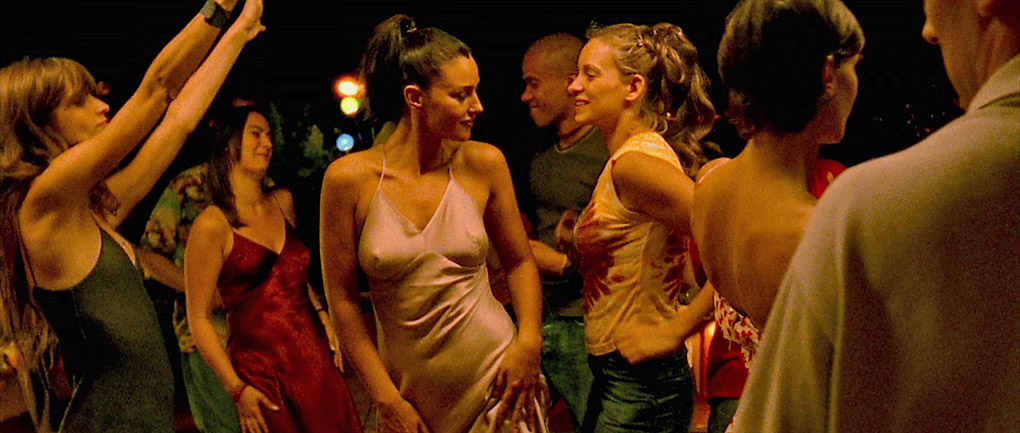
Chabrier: SFX (7:28)
A short featurette on the digital effects work done for the film by visual effects studio Mac Guff Ligne, and based around an interview with visual effect supervisor Rodolphe Chabrier. The work includes the reframing of shots, the removal of camera shadows (that’s still a tough one when it falls on patterned clothing), adjustments made to film grain to composite shots, the creation of virtual windows in cars that the camera is able to then pass through, adding a virtual penis to the rapist, and, of course, the fire extinguisher assault, which is covered in detail. Plenty of before-and-after examples are included, and it makes for very revealing and frankly fascinating viewing. I could easily have watched a good deal more on this.
Heller-Nicholas: Time Destroys All Things (14:32)
Critic Alexandra Heller-Nicholas (whose books include Rape-Revenge Films: A Critical Study) delivers a really perceptive and well-argued analysis of both cuts of a film whose every viewing she describes as trauma-inducing. She examines the different journeys that the characters undergo in the alternative cuts of the film and how it changes how we read them as an audience. Unsurprisingly, there is considerable focus on the horrific rape scene, which she links to real-world sexual assaults, our responses to them and their treatment in cinema. She also quotes from Mark Kermode’s defence of the film in his half of the Sight & Sound dual response that I mentioned above, which is absolutely worth hunting out and reading if you can.
Deleted Scene (0:37)
A brief deleted scene that shows Alex in hospital after the attack, photographed upside down by a camera that drifts and wanders disconcertingly in a similar manner to the shots that open the film.
Music Videos
Two music videos titled Stress (4:43) and Outrage (4:35), each comprised of drifting hand-held footage at two of the film's locations and set to electronic tracks by Thomas Bangalter, one half of Daft Punk and the man responsible for the film's music score.
Original Trailers
Here you’ll find two edits of the original theatrical trailer. The Uncut ‘18’ Certificate Trailer (1:41) gives a hint of what you’re in for without revealing too much plot detail. The Censored ‘15’ Certificate Trailer (1:45) is essentially the same, but with brief shots of drug use, a threat made with a knife, a bottle broken over someone’s head and a single shot from the fire extinguisher assault replaced with positive press quotes about the film.
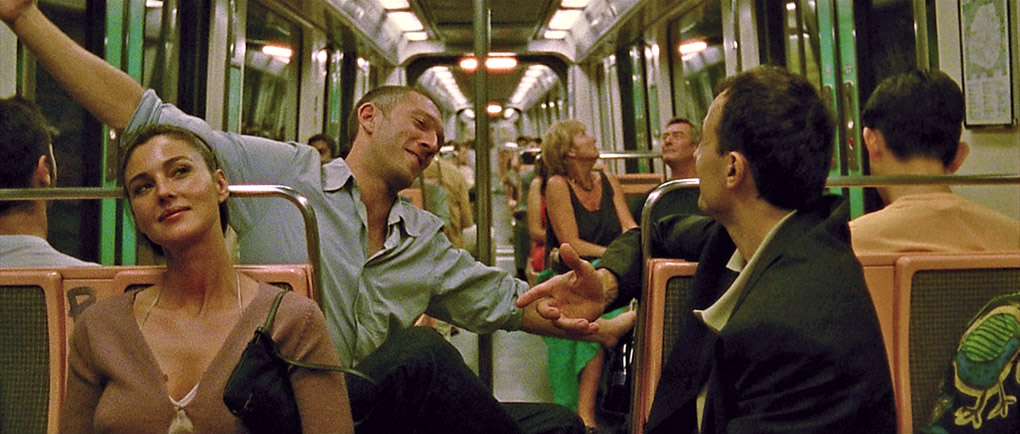
Teasers
There are six of these, ranging in length from 19 to 45 seconds. Three are semi-abstract mood pieces (the most potentially offensive of which appears to be the underground walkway as seen from the viewpoint of the rapist whilst committing the assault), one is a little misleading, but two of them point you in the right direction. The ones containing dialogue all have optional English subtitles.
Image Gallery
46 screens of promotional stills, behind-the-scenes photos, press book pages (I think) and posters.
Intoxication (2002) (5:09)
An interview with director Stéphane Drouot, who appears in the opening scene opposite Philippe Nahon as the Butcher from Seul contre tous and who talks here about how circumstance messed with his filmmaking ambitions and led him to write a book instead. There's a melancholy feel to this chat, conducted as it is in Druout's dingily lit kitchen to the sound of outside rainfall and kicking off with the director taking medication to help him cope with the symptoms of being HIV positive. This was shot by Gaspar Noé in 2002.
Easter Egg: Creuser des caisses (2:04)
A short, tucked-away extra that highlights and identifies all of the album covers in the background of a scene in Pierre and Alex’s apartment. In case you prefer to find this for yourself I’ll put the instructions on how to locate it at the bottom of the page as a small footnote.
DISC 2
Straight Cut (89:34)
Ah, this is a tricky one. First screened in 2019 at the 76th annual Venice International Film Festival and prepared by Noé himself in apparent response o pressure from those who somehow weren't able to work out what had happened in the original cut, this newer cut re-arranges the sequences that make up the film into chronological order. I accept that some are going to like this version, and in the special features Alexandra Heller-Nicholas makes a strong case for how it allows us to read the events that unfold in a different but still interesting light. For me, however, this effectively destroys one of the aspects that makes the film work as well as it does, stripping it of its singular approach to the telling of a story in which information is designed from the off to be revealed in a particular way. In the Straight Cut, there’s no mystery, no questioning of why such a violent act would be perpetrated, no piecing together of character details as more information is retrospectively revealed. In the original cut, we are presented with a puzzle that requires us to move steadily back in time and piece together the emerging details to solve, then reflect on what this means for the characters and the fate we (but not they) are now aware they are facing. In the Straight Cut, there is no such puzzle, and it instead unfolds as a more straightforward rape-revenge drama in which a series of events unfold in a more traditional and frankly less interesting manner.
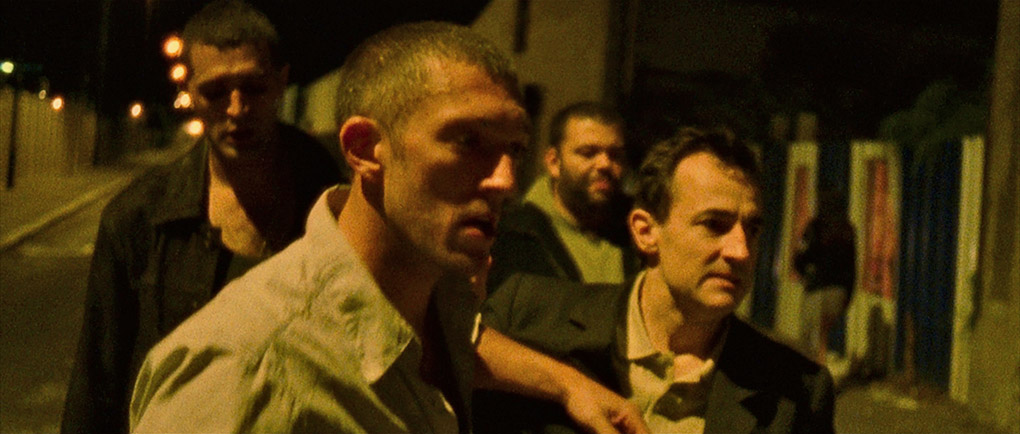
The camerawork, sound design, acting and the direction of the individual sequences still impress, of course, but for me, putting the scenes in chronological order effectively castrates the film. I seem to remember that the special edition DVD of Christopher Nolan’s similarly structured Memento included an option to do likewise with that movie, and I still recall my contempt for the very notion of doing so. It almost felt (and you’ll have to excuse my slightly condescending attitude here) like Memento for Dummies, a version that doesn’t require any work on the part of an audience that the film was likely never targeted at anyway. It’s a little like taking a Picasso Cubist portrait and smoothing out the angular edges and toning down the colours. It’ll be closer to a realist painting, one that more people would instantly recognise as human, but it will no longer be the unique masterwork it once was.
That this version exists means that it’s only right that Indicator should include it in what will likely prove to be the definitive Blu-ray release of the film, and if you can get something out of this cut then that decision is more than justified. But having seen this version once, I’ve now put it on the shelf and have no interest in ever watching it again.
Venice Film Festival Trailer (1:41)
A trailer announcing the two cuts of the film, designed very much in the style of the film’s reverse-credits approach.
Limited Edition exclusive 80-page book
Starting off with the expected movie credits, this book then gets going with an enjoyable essay on Irréversible by freelance film programmer, writer and broadcaster Anna Bogotskaya, whose interest in New French Extremity cinema, which also gets some coverage here, was sparked by her viewing of what she tactfully describes as "not a nice film." Following this is an article written for American Cinematographer by Bob Davis that examines the film on a technical level, focussing primarily on the camerawork, the film stock and the post-production digital manipulation. Next is a BBFC case study that examines the potential problems the film created for classification board, the decisions it made and the specifics of why it made them, and makes a convincing case for why the two most controversial scenes are justified inclusions. As the resport says of the decision to stay with the rape scene without cutting away, "the viewer is thus held hostage to Alex’s ordeal for a seemingly endless period." Even before I started on the critical responses I was gearing myself up for some hostile words, having read quite a few when browsing for quotes to top this review, one of which – of course – is also cited here. As is so often the case, it's the more positive responses that come across as the most throughtful, and it was interesting to see Noé's own comments on the gender devide in the reaction to the rape scene echoed by Angelique Chrisafis when she wrote, "Broadly, of the gaggle of journalists I knew who had seen Irreversible, the men walked out, the women stayed. The majority of the men said it was a bloody disgusting, pathetic display of bravado and an exploitation of women – one walked out after five minutes, before the rape scene was anywhere near. A lot of the women, in turn, said it was an important piece." I turn the page, having already set my review by this point, and the piece from Sight and Sound that I mentioned in my review and from which the second quote at the top is drawn is reproduced in full, which is great for anyone buying this release as it's not available online but does act as a prod for me to get my hands on the booklet before I post my review instead of afterwards. There's also a piece about the Straight Cut, which includes quotes from Noé on his reasons for creating this version, which include the claim that many viewers "didn’t understand certain aspects of the story." This did, a little unfortunately, remind me of when John Sayles (at least I think it was Sayles) used to do uncredited work on Hollywood scripts to make an extra buck and was often brought in to dumb down scripts to make them more audience-friendly. Finally, there is a piece on the short film, Intoxication, by Anthony Nield.
Irréversible is one of those rare films whose power to disturb, upset and even outrage an audience has not diminished one iota in the years since it was first unleashed. It’s one that some will still elect to steer well clear of, while a single viewing will doubtless have proven quite enough for a good many others. Coming back to it after a decade-long break, I think I was even more shaken by the rape scene than I was on my first viewing, but I was also even more impressed by the sheer power and intelligence of what remains a deeply troubling but intensely cinematic audio-visual experience. Not all things, it seems, are destroyed by time after all. If you’re up for it, then Indicator’s 2-disc Blu-ray is everything you could want from a special edition, with a top-notch transfer, a lovely attention to detail and a frankly brilliant selection of special features. Some will still hate it, others will prefer to steer clear, but for those willing to go to the dark places that Noé takes us, this has to get our highest recommendation.
If you want to locate the easter egg detailed above, go to the special features menu, select Music Videos, rest the cursor on Play All and then press right on the remote.
|